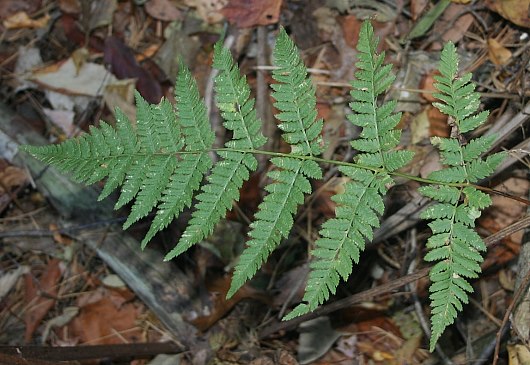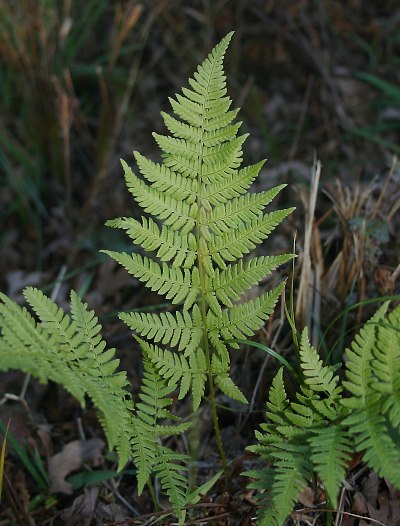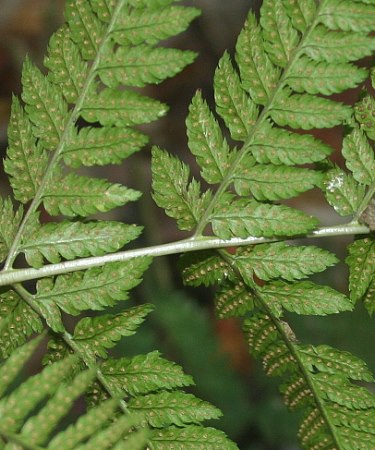Description: This perennial fern typically consists of a loose tuft of 1-5 ascending leaves. These leaves are semi-evergreen: In the northern part of this fern's range, they are deciduous, while in the southern part of its range they are evergreen. The leaves are 8-28" long and 4-10" across; the petioles are up to 1/3 the length of their leaves. Each leaf is bipinnate-pinnatifid in structure, ovate-lanceolate in outline, light to dark green on the upper surface, and hairless, consisting of up to 18 pairs of pinnate leaflets. Each leaflet is lanceolate-oblong or deltoid-oblong in outline, consisting of up to 18 pairs of subleaflets. The lower pairs of leaflets are more deltoid than the middle to upper pairs. Each subleaflet is cleft along its margins and sharply toothed, appearing almost spiny; it is oblong-lanceolate or oblong in shape. The lower two pairs of leaflets are unequally deltoid: their lower subleaflets are usually longer than their upper subleaflets. Furthermore, the basal subleaflets (adjacent to the rachis) of these lower leaflets are usually longer than their second or third subleaflets; this is an important identifying characteristic for this species.

The slender
petioles are light green and sparsely to moderately covered with chaffy
scales that are light brown. Small round sori (spore-bearing
structures) develop on the undersides of the leaves during the summer;
they are located about halfway between the midvein and margins of each
subleaflet. Each sorus has an eglandular indusium (a glandless
protective membrane) that fades away with age. The spores of the sori
are distributed by the wind during late summer or fall. As winter
approaches, the leaves become less erect and tend to sprawl across the
ground. The root system is fibrous and rhizomatous. New leaves are
occasionally produced from the rhizomes as vegetative offsets.
Cultivation:
The preference is light shade to dappled sunlight, moist conditions,
and a slightly acidic soil containing sand or rocky material. The
leaves remain in good condition throughout the summer and may persist
during the winter where winters are not severe.

Range
& Habitat:
The Toothed Wood Fern is occasional in northern Illinois, west-central
Illinois, and the Shawnee Hills of southern Illinois; elsewhere in the
state, it is rare or absent (see Distribution
Map). This fern is native to both North America and Europe.
Habitats include moist sandy woodlands and savannas, sandy swamps and
seeps, rocky upland woodlands, sandstone ravines, forested bogs, and
sandy banks along streams.
Faunal Associations:
An insect of the Miridae, Monalocoris americanus,
feeds on the developing sporangia (individual spore-bearing structures)
of the Toothed Wood Fern and other ferns. The caterpillar of a moth, Herpetogramma
theseusalis (Translucent Cat), folds the leaf margins or leaf
tips of Dryopteris spp. (Wood Ferns, Shield Ferns)
while constructing a protective shelter. Generally, the foliage of
Shield Ferns are more or less toxic to herbivorous mammals or birds,
although the White-Tailed Deer and Ruffed Grouse sometimes eat their
leaves, especially during the winter, when other sources of food are
scarce.
Photographic Location:
The Jasper-Pulaski Fish and Wildlife Area in northwestern Indiana.

Comments: The leaves of the Toothed Wood Fern are more intricate and lacy in their appearance than the leaves of many other ferns because of their complex structure and strongly toothed margins. This fern is very similar in appearance to a closely related species, Dryopteris intermediate (Intermediate Wood Fern), and they sometimes hybridize. To distinguish these two species, it is necessary to examine the basal subleaflets (those closest to the rachis, or central stalk) of the lowest pairs of leaflets on the compound leaf. On the Toothed Wood Fern, these basal subleaflets are longer than the second or third subleaflets of the lowest leaflets (providing the latter with a deltoid appearance); on the Intermediate Wood Fern, the second or third subleaflets are longer than the basal subleaflets on the lowest leaflets (providing the latter with an ovate-lanceolate appearance). More than one fern leaf should be examined, because this distinction is not always reliable. In northern areas where winters are quite cold, the leaves of Toothed Wood Fern tend to die down, while the leaves of Intermediate Wood Fern are reliably evergreen – this distinction disappears in warmer climates. Generally, other Dryopteris spp. (Wood Ferns, Shield Ferns) in Illinois have leaflets or subleaflets that are less divided and less strongly toothed than either the Toothed Wood Fern or Intermediate Wood Fern. All of these ferns have small round sori on the undersides of their leaves. Another scientific name of the Toothed Wood Fern is Dryopteris spinulosa. As a result, it is sometimes called the Spinulose Wood Fern.